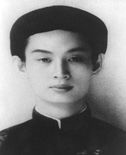PHẬT GIÁO HÒA HẢO
HARMONY BUDDHISM
GỌI ĐOÀN THANH NIÊN
APPEAL TO THE YOUNG PEOPLE
When this poem was written, the Indochina War started to change its course in favor of the anti-colonial resistance movements in Vietnam, with the army of the Japanese Empire being on the verge of overthrowing the French colonial government and substituring the pro-Japanese indigenous for it. As one of the contenporary revolutionaries and prominent leaders of anti-colonial movements in the South, Lord Master encouraged the Vietnamese young people to take advantage of this opportunity to stand up and join forces to repel the French expeditionary corp and cliques off their country once and for all. He uses the analogy of Tiger and Dragon to imply that the Vietnamese people, especially the young ones, must be aware of the strength of their race, which they must believe carries in their blood the pride of the Dragon and Fairy scion. Thus there is no reason why they fear the Tiger, who loses its home-based support due to their preoccupation to fight the Nazi on the European theatre. In his view, the Japanese soldiers' patriotism might make them deserve for the local young people to take as a role model despite their sheer lack of modern military training and weaponry.
GỌI ĐOÀN THANH-NIÊN
1. Hỡi thanh-niên trong nhà Nam-Việt !
Thanh-niên đừng mài-miệt truy-hoan.
Cùng nhau hiệp bạn vầy đoàn,
Luyện rèn thao-lược đặng toan báo cừu.
Cứu được nước danh lưu thanh-sử,
Noi tinh-thần quân lữ Phù-Tang.
Lòng yêu Tổ-quốc hoàn-toàn,
Xông-pha chiến-địa gian-nan sá gì !
Chớ có ngủ li-bì trong mộng,
10. Để dân ta mãi sống khốn-cùng.
Á-Đông súng nổ đùng-đùng,
Thì ta cũng phải vẫy-vùng thoát-ly.
Đừng nhu-nhược, mê-si tửu sắc (1),
Mà buông tha lũ giặc cùng đường.
Thanh-niên nghĩa-vụ phi-thường,
Phận là phải biết yêu thương giống nòi.
Nay chẳng lẽ ngồi coi thắng bại,
18. Của cọp, rồng trên dãy đất ta.
Một mai cọp đã lìa nhà,
20. Biết rồng có chịu buông tha chăng cùng?
Vậy anh em phải chung lưng lại,
Dùng sức mình đánh bại kẻ thù.
Tỏ ra khí-phách trượng-phu,
Vung long-tuyền kiếm tận tru gian thần.
Xưa Nước đã bao lần khuynh-đảo,
Được cứu nguy nhờ máu anh-hùng.
Hy-sinh báo quốc tận trung,
Đem bầu nhiệt-huyết so cùng sắt gang.
Việt-Nam là giống Hồng-Bàng,
30. Muôn đời xa lánh tai-nàn diệt-vong.
Sài-Gòn, năm 1943
1.-Sắc: khái niệm Phật giáo, chỉ bất cứ điều gì có thể nhìn thấy, thường hấp dẫn cho mắt của con người. Trong bối cảnh này, sắc thường được gọi là một đối tượng kích dục, khi kết hợp với rượu, có ảnh hưởng đáng kể, như làm mờ mịt ý thức của người thích nhìn vào nó. Vì vậy, người tu tốt nhất không nên để cho mình rơi vào cạm bẫy của rượu và sắc, đó là nguyên nhân rất phổ biến gây ra đồi trụy và người tu càng phải tránh xa.
APPEAL TO THE YOUNG PEOPLE
To the young people of Vietnam!
Don’t succumb to self-pleasing addiction.
Bond yourselves into an association,
Train yourselves to avenge your nation’s loss.
The national saviour’ll have a historical gloss,
Adopt the spirit of Japanese soldiers.
They are their nation’s utter lovers,
Battlefield risks will never thwart them!
Don’t keep burrowing in your dreams,
For our people to forever live in calamity.
Gunshots in Asia resound loudly,
We ourselves must struggle for freedom.
Don’t be feeble clinging to alcohol and form (1),
Lest you should release cornered enemies.
Extraordinary are young people’s duties,
To love their race is their top priority.
How can they now sit watching the rivalry,
Of the tiger and dragon on our land.
As the tiger lost its home’s helping hand,
Is it sure that the dragon will let it go?
Thus, you must back to back assault,
With your forces, let's bring on their defeat.
Show them your brave man’s spirit,
Wield the Dragon-Spring sword to kill disloyals.
The nation has suffered repeated upheavals,
It owes as many rescues to heroes’ mettle.
They sacrifice for their country as the loyal,
With their iron-clad devotion and valiance.
The Vietnamese are of Hong Bang descent,
Never let yourselves fall into extinction.
Saigon, 1943
1.- Form: a Buddhist concept, designating anything visible, somewhat attractive to the eye of a worldling. In this context, form is often referred to as a sensuous object that, when combined with alcohol, increases its impact on the person concerned, in terms of blurring their conscienciousness. Thus a good practicer should not let themselves fall into the trappings of alcohol and form, which are the common cause of debauchery and must be eschewed.
1.-Sắc: khái niệm Phật giáo, chỉ bất cứ điều gì có thể nhìn thấy, thường hấp dẫn cho mắt của con người. Trong bối cảnh này, sắc thường được gọi là một đối tượng kích dục, khi kết hợp với rượu, có ảnh hưởng đáng kể, như làm mờ mịt ý thức của người thích nhìn vào nó. Vì vậy, người tu tốt nhất không nên để cho mình rơi vào cạm bẫy của rượu và sắc, đó là nguyên nhân rất phổ biến gây ra đồi trụy và người tu càng phải tránh xa.
1.- Form: a Buddhist concept, designating anything visible, somewhat attractive to the eye of a worldling. In this context, form is often referred to as a sensuous object that, when combined with alcohol, increases its impact on the person concerned, in terms of blurring their conscienciousness. Thus a good practicer should not let themselves fall into the trappings of alcohol and form, which are the common cause of debauchery and must be eschewed.

